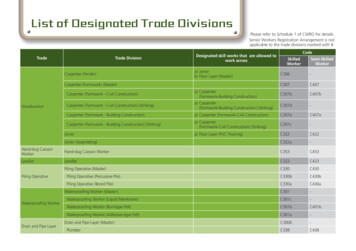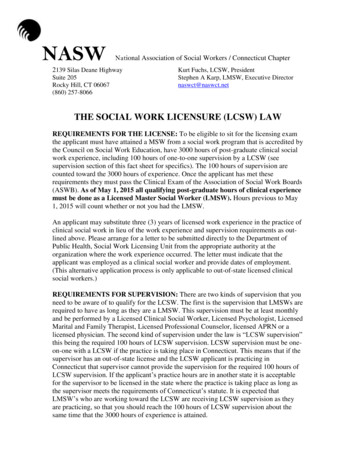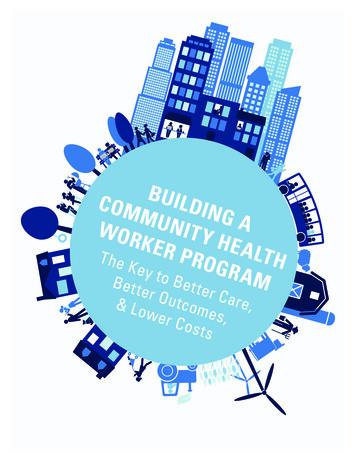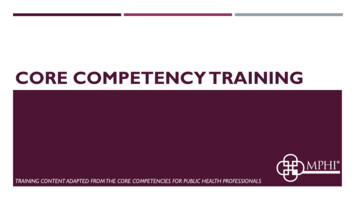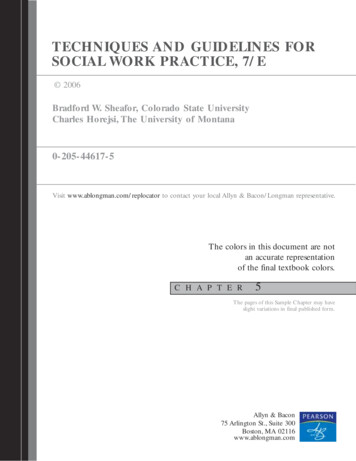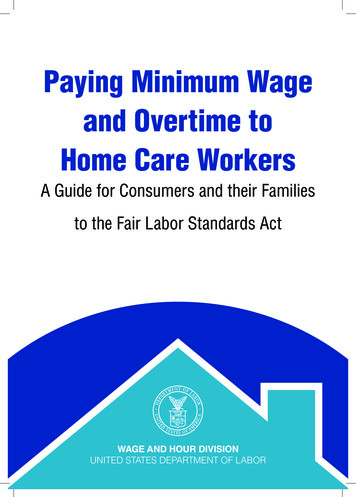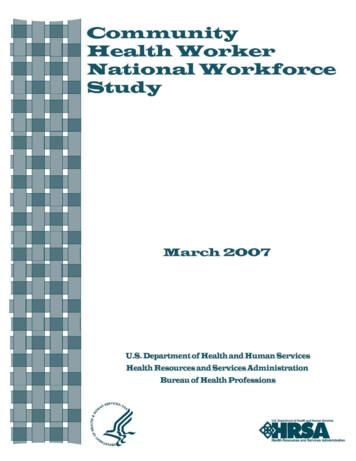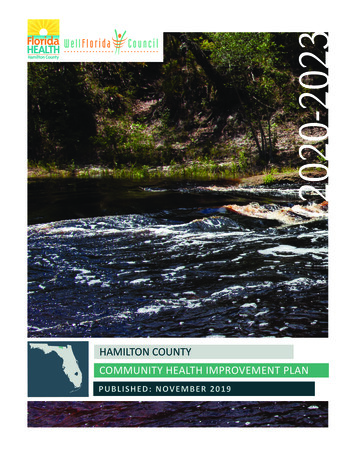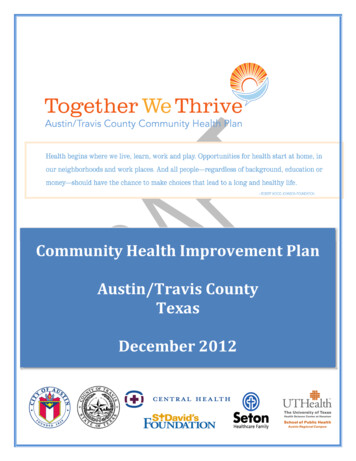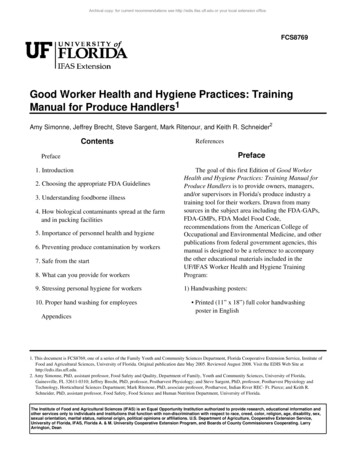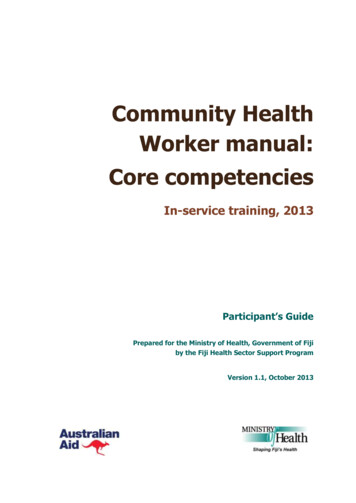
Transcription
Community HealthWorker manual:Core competenciesIn-service training, 2013Participant’s GuidePrepared for the Ministry of Health, Government of Fijiby the Fiji Health Sector Support ProgramVersion 1.1, October 2013
Commonwealth of Australia, 2013Copyright protects this publication. Except for purposes permitted by the Australian Copyright Act 1968and the Fijian Copyright Act, 1999, reproduction, adaptation, electronic storage, and communication tothe public is prohibited without prior written permission. Enquiries should be addressed to Abt JTA, POBox 1874, Milton QLD 4064, Australia.The Ministry of Health, Government of Fiji, has a non-exclusive, non-expiring licence to copy, publish,and adapt this publication.Any third party material, including images, contained in this publication remains the property of thespecified copyright owner unless otherwise indicated, and is used subject to their licensing conditions.Version: 1.1Edition: October 2013The Fiji Health Sector Support Program (FHSSP) is an Australian Government initiative, providing supportto the Fiji Ministry of Health to delivery essential health services to the people of Fiji. The FHSSPsupports activities that contribute to improving health outcomes in maternal and child health,strengthening diabetes and hypertension prevention and management, and revitalising primary healthcare and targeted health systems strengthening. FHSSP is implemented by Abt JTA on behalf of theAustralian Government.
ContentsParticipant’s GuideContentsForeword .iAcknowledgements . iiAbbreviations . iiiOverview . 1Training plan. 1Section 1 — Welcome and introduction . 71.1Skills of a CHW. 81.2Purpose of the CHW role . 10Section 2 — Work with the community to develop healthy outcomes . 152.1Work closely with your community . 152.2Work closely with other groups and key stakeholders . 222.3Build a picture of the community to assess needs . 342.4Prepare information and plans to build health in the community . 43Section 3 — Implement community health promotion programs. 493.1Identify important contacts . 493.2Build effective relationships using good communication skills . 553.3Track what is happening in the community . 573.4Work well with nursing staff and medical areas . 633.5Keep the dispensary in good order (where relevant) . 65Section 4 — Provide First Aid emergency response . 714.1Provide First Aid skills and help the community to learn these skills . 714.2Look out for risks and hazards in the community . 734.3Make decisions in emergencies . 774.4Reduce the impact of emergencies and disasters . 824.5Conclusion . 87Fiji Health Sector Support Program i
Community Health Worker manual: Core competenciesIn-service training, 2013Annexes . 89Annex A — Units of Competency . 90Annex B — PowerPoint slides . 93Annex C — Basic letter template . 95Annex D — Participant feedback form . 96 ii V1.1 October 2013
ForewordParticipant’s GuideForewordCommunity or Village Health Workers work voluntarily intheir communities to provide First Aid emergencyresponse, engage with the community to develop healthyoutcomes, and implement health promotion programs.This manual is a guide to train Community/Village HealthWorkers in the core competencies they are expected tohave to effectively perform their role in their respectivecommunities.It is the culmination of the collaborative effort of key stakeholders of primary healthcare in Fiji. The Ministry of Health, together with other ministries and donor partners,continue to engage with communities to promote healthy lifestyles and behaviourchange to reduce the double burden of disease in our midst.Promoting wellness in the community is a key function of the Community/VillageHealth Worker.It is our hope that this guide will be used by all those who have the passion to train thevolunteers to gain the knowledge and skills to equip them to perform their role well inthe communities they serve.Mrs Una BeraActing Deputy Secretary for Public HealthMinistry of HealthFiji Health Sector Support Program i
Community Health Worker manual: Core competenciesIn-service training, 2013AcknowledgementsWe would like to thank the following for their support, extensive knowledge andexpertise, which together has resulted in the production of the manual: Ministry of i-Taukei Affairs Ministry of Health staff Fiji Health Sector Support Program. ii V1.1 October 2013
AbbreviationsParticipant’s GuideAbbreviationsANCAntenatal clinicARFAcute rheumatic feverBCGBacillus calmette-guérin [vaccine]BMIBody mass indexCBAChild bearing age [15 to 49 years]CHAPCommunity Health Action PlanCHRChild Health RecordCHWCommunity Health WorkerCPRCardiopulmonary resuscitationDHSDivisional Health SisterDISMACDisaster Management Committee [Fiji]DTPDiphtheria-tetanus-pertussis [vaccine]ECPEmergency contraceptive pillFPFamily planningGOPDGeneral Outpatients DepartmentHBVHepatitis B vaccineHCHealth centreHibHaemophilus influenza type BHIVHuman immunodeficiency virusIECInformation, education, and communication [materials]IMCIIntegrated management of childhood illnessIUCDIntra-uterine contraceptive deviceLTALand Transport AuthorityMCHMaternal and child healthMOMedical OfficerMoEMinistry of EducationMoHMinistry of HealthMRMeasles-rubella [vaccine]NCDNon-communicable diseaseNGONon-government organisationNPNurse PractitionerOPVOral polio vaccineORSOral rehydration solutionFiji Health Sector Support Program iii
Community Health Worker manual: Core competenciesPAProvincial AdministratorPNCPostnatal clinicRHDRheumatic heart diseaseSDHSubdivisional HospitalSDHSSubdivisional Health SisterSNAPSmoking Nutritional Alcohol Physical InactivitySOPDSpecialist Outpatient DepartmentSTISexually transmitted infectionTTTetanus toxoid [vaccine]VCCTVoluntary counselling and confidential testing iv In-service training, 2013V1.1 October 2013
Glossary of key termsParticipant’s GuideGlossary of key termsBurden of diseaseThe total impact of a health problem, such as non-communicablediseases, on the community.CommunicablediseaseAn infectious disease that can be transmitted from one person toanother.CommunitydevelopmentThe practice of empowering community members to develop theirskills and potential to build a strong, happy, healthy, and safecommunity.CommunityengagementA set of processes and activities that involve working together withthe community to help them identify and solve problems that affecttheir wellbeing.Community profileAn analysis of the geographical, population, health, and asset andwellness characteristics of a community, to contribute to betterhealth planning.EvaluationA process of assessing whether an activity has met its goals orobjectives.Health promotionActivities that help individuals and communities to identify andreduce their risk factors for disease, and to behave in ways that willmake them safer and healthier.MonitoringA continuous process of assessing whether a situation or activity iscreating change in the community.MortalityRate of deaths in a community.Needs analysisThe process of identifying the requirements of the community andspecific groups in the community, such as mothers, babies andchildren, people with diabetes, or those at risk of diabetes or heartdisease.Non-communicablediseaseA non-infectious disease caused by risk factors such as physicalinactivity, poor diet, and smoking, e.g. diabetes and heart disease.PreventionStrategies to promote wellness and reduce the occurrence ofaccidents, illnesses, and injuries in a community.Self-screeningProcesses and tools the community can use to monitor their ownhealth as a means of increasing individuals’ awareness and ownershipof their own health and the health of their family.WellnessA state of health that looks holistically at social, emotional, spiritual,environmental, occupational, intellectual, and physical dimensions.Fiji Health Sector Support Program v
Community Health Worker manual: Core competencies vi In-service training, 2013V1.1 October 2013
OverviewParticipant’s GuideOverviewTraining plan This workshop will be conducted for the communities where most CommunityHealth Workers live. Community Health Workers from a number of communities will attend eachtraining session. The training will take place over 2–3 days. A training timetable will be provided when you attend the training.Community Health Workers participating in training. (FHSSP 2013)Fiji Health Sector Support Program 1
Community Health Worker manual: Core competenciesIn-service training, 2013Topics coveredTopics covered in this training include: Why your community should have a Community Health Worker (CHW). Skills you need as a CHW. Working closely with your community and other important groups. Building a picture of the community (a profile to assess needs). Making plans and giving information to build health in the community. Knowing who the important contacts are in the community. Developing useful relationships. Using effective communication. Keeping track of what is happening in the community. Working well with nursing staff and medical areas. Keeping the dispensary in good order. Providing First Aid and helping the community to learn these skills. Looking out for risks and hazards in the community. What to do in an emergency.Community Health Workers working on a group activity during training. (FHSSP 2013) 2 V1.1 October 2013
OverviewParticipant’s GuideWhat is a Community Health Worker?In Fiji, a Community Health Worker, or CHW, is someone who: Volunteers in their community to promote health and wellness. Works with people and groups to create a healthy community. Promotes health and wellness, particularly for maternal and child health. Focuses on reducing ‘lifestyle’ diseases or non-communicable diseases (NCDs),such as diabetes and heart disease.They can do this in many ways, such as: Helping to organise the community for local health planning. Encouraging increased use of the existing health services. Promoting good health practices. Teaching and working with the community to make a healthy place for all. Monitoring activities and telling people about: Practices that have improved health in their community. Major health problems in the community.What is a healthy community?(FHSSP 2013)Fiji Health Sector Support Program 3
Community Health Worker manual: Core competenciesIn-service training, 2013Many factors affect the health of people and their communities. These factors include: Income level Work Housing Transport Family and social relationships Access to and use of basic services, such as safe water supply and sanitation Quality health services Taking responsibility for self and children Quality of the environment.Any actions that improve these factors will help improve health outcomes. Thishappens as the community has better knowledge of what it needs to be healthy.Why have this training for CHWs?This training was created to strengthen the role of CHWs to support the wellnessapproach in communities throughout Fiji.The CHW role, which is an unpaid volunteer role, has been used in the past as a semiclinical/treatment person in the community, without relevant training. Now, with thecrisis of non-communicable diseases (NCDs), especially diabetes, there has been a shiftin focus to promote primary health care and health promotion in the communities ofFijian villages, urban communities, and peri-urban settlements.CHWs need skills and knowledge to work effectively with community members, healthservices, and the zone nurse. These skills will help CHWs in a renewed focus onmaternal and child health, as well as diabetes and hypertension identification,prevention, and management.The focus of CHWs continues to be on: Supporting families and communities. Promoting access to health services, so people will seek treatment early. Managing existing health issues. 4 V1.1 October 2013
OverviewParticipant’s GuideTraining manuals for CHWsThe following manuals make up the full training package for the Community HealthWorker training program: Community Health Worker manual: Core competencies (this manual) Community Health Worker manual: Promote child health in the community Community Health Worker manual: Promote safe motherhood in the community Community Health Worker manual: Promote wellness in the community.This manual explains the core competencies and is the first training manual. Theothers will follow. Each will support CHWs to develop knowledge and skills to sharewith their communities to promote: Child health Safe motherhood Wellness.Why are CHWs participating in the training?The participants in this training are all volunteers from their communities, who act asCommunity Health Workers.CHWs have received basic First Aid training. Now they need to extend their generalknowledge and skills to promote health within each community. The goal is to raiseawareness among people and families, to spread the knowledge and skills to preventillness and promote wellness.CompetencyThis is competency-based training, designed to build your knowledgeand skills in this area of your work. This means you will demonstrateyour ability and knowledge at training sessions, to provide evidence ofyour competency to:1. Engage the community to develop healthy outcomes.2. Implement community health promotion programs.3. Provide First Aid emergency response.Fiji Health Sector Support Program 5
Community Health Worker manual: Core competenciesIn-service training, 2013To do this you will learn to: Use effective community engagement and development methods to achieveplanned health outcomes. Ensure health information and plans support the engagement and development ofthe community. Work in partnership with the community to implement activities to promotehealthy lifestyles, behaviour change, and seeking treatment early, and to buildpositive attitudes to health. Collaborate with other health workers to support health promotion and services inthe community. Provide First Aid in emergencies, and maintain and implement skills training. Practise and implement emergency plans and preparations.For more detail about the Units of Competency that this training is based upon, seeAnnex A of this Participant’s Guide.Contact detailsPlease write your facilitator’s name and contact details in the boxes below.Facilitator’s namePhone contactPresenting to the group during Community Health Worker training. (FHSSP 2013) 6 V1.1 October 2013
Section 1 — Welcome and introductionParticipant’s GuideSection 1 — Welcome andintroductionWelcomeWelcome to the training for Community Health Workers. The objectives of this trainingare to develop your knowledge and skills, so you can:1. Engage the community to develop healthy outcomes.2. Implement community health promotion programs.3. Provide First Aid emergency response.The purpose of this training is to support communities to build and maintain health forall, by developing the skills of Community Health Workers.This session looks at the fundamental skills and knowledge that you will need todemonstrate.Community Health Workers support their community to maintain health for all. (FHSSP 2013)Fiji Health Sector Support Program 7
Community Health Worker manual: Core competenciesIn-service training, 20131.1 Skills of a CHWWhen you are working as a CHW you will need to demonstrate the following skills: Find and gather resources for your community. Maintain good working relationships with community leaders, other stakeholders,and other CHWs. Be organised and manage your time effectively. Plan and carry out activities and programs with the community. Communicate effectively, including basic letter writing skills. Be a role-model for healthy behaviours. Build a solid support base, particularly with community leaders.These skills and knowledge are covered in more detail throughout the training.Topics coveredThe topics covered in this manual aim to develop the core competencies that you arerequired to demonstrate: Community engagement for health and wellness: What is health and wellness? Define social aspects of health and the dimensions of wellness. What is community health? What is a community health program (roles and responsibilities)? Find and use resources for health and wellness. Introduction to Community Health Action Plans (CHAPs). Community health promotion — How to understand your community’s healthneeds in partnership with the community and leaders to: Develop illness and accident prevention strategies, and promote positive andhealthy lifestyles. Access and develop information, education, and communication (IEC) materialsthat are suitable for your community. Understand how to refer members of the community to health services usingthe correct process (when there are signs of illness). Understand and respond to environmental health issues (e.g. water, sanitation,cooking, and gardening). Identify and manage hazards and risks, particularly communicable diseases anddiseases carried by pests. 8 V1.1 October 2013
Section 1 — Welcome and introductionParticipant’s Guide Promote maternal health — including family planning, antenatal visits,nutrition, and birth preparedness plans (including readiness for complicationresponse, such as transport). Promote child health — Child Health Record (including immunisations,nutrition, oral health, and weight charts). Promote healthy lifestyle and behaviour change to reduce the burden ofcommunicable and non-communicable diseases in the community. Compile a kit of useful key materials from: The medical area and health centres. A wide range of other ministries (e.g. Land Transport Authority, Agriculture,Development, and Education) and groups (e.g. church groups, communitygroups, and training groups). Promote and partner with other relevant stakeholders (especially nurses in themedical area) to promote regular community outreach and discharge planningimprovements. Have effective First Aid skills for emergencies and natural disasters, and riskidentification skills.If you successfully complete all of the activities in this training, it will provide evidenceof your competence in these core areas of competency for CHWs.My notesFiji Health Sector Support Program 9
Community Health Worker manual: Core competenciesIn-service training, 20131.2 Purpose of the CHW role(FHSSP 2013)CHWs can improve wellness and reduce illness by: Working with the community for local health planning. Promoting more use of existing health services. Promoting good health practices. Teaching and working with the community to make a healthy village for all. Monitoring activities to see whether they have improved health in the community. Identifying and telling people if there are any major health problems. Improving maternal and child health. Reducing the burden of communicable and non-communicable diseases. 10 V1.1 October 2013
Section 1 — Welcome and introductionParticipant’s GuideGroup and partner activityBrainstormConsider the following areas of health in your community: Maternal and child health. Communicable and non-communicable diseases.Briefly brainstorm with the group some of the issues that are importantin your community for these areas of health.DiscussNow select three issues related to each of these areas, which are thehighest priority for you.Turn to the person sitting next to you. Take turns to discuss the issuesand challenges that your community faces. How could you improvethese areas of health in your community?Fiji Health Sector Support Program 11
Community Health Worker manual: Core competenciesIn-service training, 2013Think about some of the following issues in your community: Maternal and child health: Women attending antenatal visits early in pregnancy. Plans to prepare for birth early in pregnancy. Promoting breastfeeding in all infants and continuing up to2 years. Taking infants and children under 5 years regularly to the clinicfor check-ups and for scheduled immunisations. Preventing illness with good nutrition for babies and children. Recognising signs of a sick child quickly and helping children andbabies with diarrhoea by knowing how to make and give oralrehydration solution (ORS). Taking a sick child to the clinic early. Recognising danger signs.The level of infectious diseases (i.e. communicable diseases): Recognising the causes of infection and how they spread in thevillage or community. Identifying problems in the community environment (e.g. watersupply, sanitation, exposed waste and rubbish, presence ofdisease-carrying insects). Identifying poor personal hygiene and food practices.The impact of non-communicable diseases (NCDs): Seeking treatment early when there are signs of illness. Screening to identify, monitor, and detect health problems early(especially for weight, blood sugar and blood pressure, andcancers). Effectively managing existing illness. Awareness of lifestyle factors linking to NCDs (smoking, drinking,poor nutrition, STIs, and lack of regular physical activity).ShareYou and your partner will be invited to share your stories and discussthem with the group.During this discussion, think about any positive stories and how thesecould be promoted more. Also think about the common difficulties that 12 V1.1 October 2013
Section 1 — Welcome and introductionParticipant’s GuideCHWs might face in trying to promote change in behaviour.Note: In remote or maritime communities, the CHW may have a biggerrole, due to lack of access to health services. However, this is not thecase in the majority of medical areas.Key pointThe core role of the Community Health Worker is to: Work closely with community leaders and others to promotewellness and reduce illness. Focus on maternal and child health, as well as communicable andnon-communicable diseases. Support emergency First Aid for the community.If you are presenting this information to the community, see Annex B fora PowerPoint slide that can be used, or otherwise drawn on butchers’paper or a whiteboard/blackboard.Conducting a maternal and child health clinic for new mothers. (FHSSP 2013)Fiji Health Sector Support Program 13
Community Health Worker manual: Core competenciesIn-service training, 2013My notes 14 V1.1 October 2013
Section 2 — Work with the community to develop healthy outcomesParticipant’s GuideSection 2 — Work with thecommunity to develop healthyoutcomes2.1 Work closely with your community2.1.1 What is community engagement?‘Community engagement’ is a planned process of working together with thecommunity to deal with issues affecting their wellbeing. It is ‘the active involvement ofpeople in any decisions that may affect the health of them, their families and thecommunities they are linked to’.National Institute for Health Care Excellence. (2005). Community engagement for health: A preliminary review oftraining and development needs and existing provision for public sector organisations and their workers. Retrieved15 October 2013, from hda/hdapublications/p102.jsp .Steps of community engagement(FHSSP 2013)Fiji Health Sector Support Program 15
Community Health Worker manual: Core competenciesIn-service training, 2013The process of community engagement is designed to: Create transparency (i.e. an open, honest, and fair process). Increase community involvement. Promote responsibility for setting priorities. Encourage participation in change-related activities that come out of the process.By being involved in the process, community members will share in the challenges ofdeveloping their community and take pride in the results achieved throughengagement.The CHW is a vital stakeholder in any community. As a wellness advocate, you can aid‘wellness’ ways of thinking during engagement activities.Community engagement activities might include: The community identifying the health issues in their community and the causes. Brainstorming the possible solutions. Developing a Community Health Action Plan (CHAP).2.1.2 What is community development?After the community has developed its Community Health Action Plan fromcommunity engagement activities, the action phase of the process is known ascommunity development.Community development for a healthy community(FHSSP 2013) 16 V1.1 October 2013
Section 2 — Work with the community to develop healthy outcomesParticipant’s GuideCommunity development helps people to: Recognise and develop their skills and abilities. Become more responsible. Organise themselves and plan together to solve problems and needs. Develop healthy lifestyle options. Become strong and achieve their goals.At the community level, community development helps to: Promote fair use and control of assets to benefit all community members. Create jobs and other economic opportunities. Build strong, safe, and happy communities. Improve the quality of community life.A CHW, through the Turaga ni Koro, can be the community’s link to quality health care,health assistance, and guidance from the Ministry, health NGOs, and otherstakeholders.Health is important in any community development process. The CHW can providevital information and also ask for outside resources and assistance.DiscussionShare examples of any community development activity that you ormembers of your community took part in. What was the purpose of this activity? What did it achieve?Fiji Health Sector Support Program 17
Community Health Worker manual: Core competenciesIn-service training, 20132.1.3 Benefits of working with the communityThe benefits of working with the community on health issues include: Raising awareness of health issues and wellness. Focusing on particular health issues for maternal and child health, noncommunicable diseases, and wellness promotion. Creating ownership of health in the community for individuals and family health. Identifying concerns that are not directly health-related, but have an impact onhealth (e.g. environment, water safety, sanitation, housing, transport, and work). Creating an opportunity for education and training. Promoting closer links with the Nursing Station and Zone Nurse for early treatmentseeking.Case studiesWork with a partner to complete this activity.Select one of the following case studies. Discuss how you can best dealwith the situation described in the case study.Case study 1: Community development in a village settingHarvesting from a communal farm. (FHSSP 2013)ProblemA village has begun communal farming of cassava and yaqona as anincome-generating activity. This will ensure that children from the villagehave access to education, meet traditional and religious commitments,and ensure villagers have proper housing and sanitation facilities. 18 V1.1 October 2013
Section 2 — Work with the community to develop healthy outcomesParticipant’s GuideA day is put aside when the men tend to the communal farm and thewomen provide their meals. Money earned from the sale of cassava andyaqona will be spent on the above developments. However, the problemthis community faces is that they are a long way from the market to selltheir produce.EffectThe community is not able to afford the transport cost to the nearestmarket. Because it is so far away, this means they are not earningenough money from their farm to implement their development plans.Questions What are the key issues? Who could the community talk to for help? What are the next steps? For example, identify the steps to create amarket closer to them.Fiji Health Sec
Community Health Worker manual: Core competencies In-service training, 2013 iv V1.1 October 2013 PA Provincial Administrator PNC Postnatal clinic RHD Rheumatic heart disease SDH Subdivisional Hospital SDHS Subdivisional Health Sister SNAP Smoking Nutritional Alcohol
